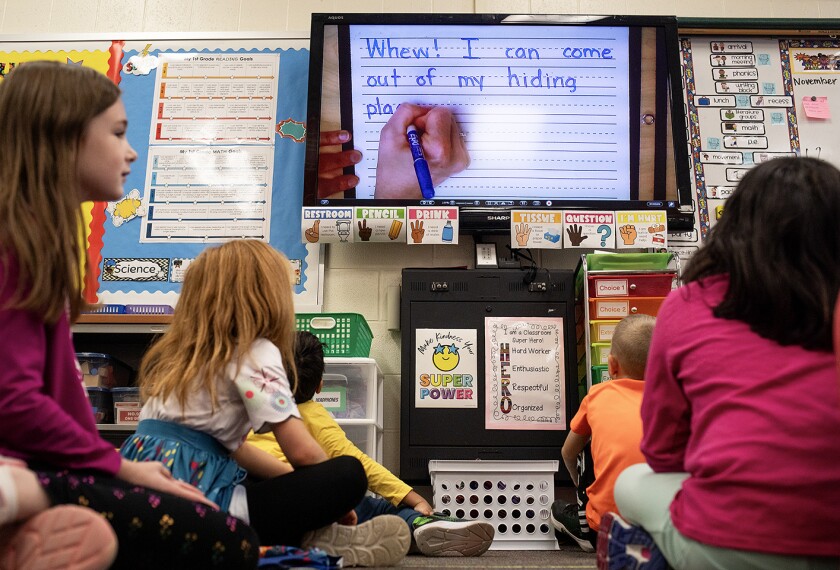Social-emotional skills provide adolescents with valuable tools to navigate the tricky world of tweens and teens. But schools tend to focus much more on social-emotional learning in the preschool and elementary years than the latter grades.
“SEL can be a forgotten domain” of learning in adolescents, said Stephanie Jones, a professor of child development and education at Harvard University, in a recent webinar hosted by the Association for Supervision and Curriculum Development.
And that’s a problem, because adolescents are going through a lot, and they need strong social and emotional skills as much, if not more, than younger students: Their relationships are becoming more complex. They’re dealing with hormonal changes and peer pressure. They’re tackling big questions about who they are, what they want to be, and what they value.
But there are fewer SEL curricula and programming designed for middle and high school students than for elementary and preschool students, said Jones, who led the development of a guide to SEL programs for middle and high schools. And of the programming that does exist, she said much of it doesn’t successfully connect to adolescents’ needs, limiting its effectiveness.
Furthermore, even though the research on adolescent-targeted SEL programs is scant, the research that does exist has found that the efforts improve students’ academic performance, prosocial behaviors, and mental and physical health, Jones said.
The net result is that developing adolescents’ social-emotional skills is too often neglected, although that might be changing.
Previous polling by the EdWeek Research Center found that pre-pandemic, a minority of district leaders said their district placed a lot of emphasis on SEL in the middle and high school grades, but those numbers started to shift during the pandemic.
In 2020, 38 percent of district leaders said their district placed a lot of emphasis on SEL in grades 6-8, and 31 percent said the same for grades 9-12. By 2022, those numbers had climbed substantially. Fifty-six percent of district leaders said their district placed a lot of focus on SEL in middle school, and 53 percent said that was the case in their high schools.
Adolescents’ SEL needs are different from younger learners
Social-emotional learning is the teaching of nonacademic skills that are essential to success in school and life—or what might be more colloquially called “life skills.” Knowing how to build positive relationships, understand your feelings, and manage behavior are some of the concepts that make up the core of social-emotional learning, said Jones, and they’re critical for preteens and teenagers to be successful in school every bit as much as for elementary school students.
But adolescents’ social and emotional needs are different from younger learners. Just like math or science, social-emotional learning builds on itself, starting with simpler skills and progressing to more complex ones. And, Jones said that’s where a lot of schools and SEL curricula fall short: They try to graft elementary-level SEL onto middle and high school learning.
The result? SEL that comes across to teens as patronizing or lame. In other words, a 12th grader may not get the same value out of mood meters as a 5th grader.
So, what does SEL for adolescents look like?
The older grades are when students have increased capacity to develop SEL skills around goal-setting and critical thinking; stress management; and effective communication, leadership, and conflict management, said Jones. It’s when students are starting to explore their identity and values, and they are looking for more autonomy and agency. They’re ready to make more of their own informed choices and tap into SEL skills around responsible decisionmaking.
SEL programs for the middle and high school levels should reflect that, supporting students in five main areas, she said:
- Emotion regulation and perseverance: These skills help tweens and teens cope with emotionally challenging situations in a productive way and persevere despite setbacks.
- Goal setting, planning, and organization: These skills are critical for students as they grow more independent and their schoolwork becomes more challenging and their schedules busier.
- Self-advocacy and agency: Both are important traits for students as they develop a better understanding of what their strengths, interests, and needs are.
- Individuated identity: Adolescence is when students start exploring and forming their identities—whether that’s their personality, beliefs, or looks—independent from their peers and family.
- Sophisticated relationships: Building relationships with others—based on mutual respect, trust, fairness, separate identities, and good communication—help students prepare for and move through the big transitions coming their way, such as high school graduation, college, and careers.
SEL may become less about explicitly teaching skills and more about giving students the chance to exercise and master the social-emotional skills they have learned, such as creating leadership opportunities or giving them decisionmaking power in their schools.
Schools should also consider how discipline aligns with their SEL work, said Jones.
“Students need to have a hand and agency in their own learning, and this is particularly important for youth,” she said.
Addressing common challenges
The most common challenges Jones hears from educators is that it’s hard to find time to implement SEL in middle and high school classes and to get students to apply the skills they’re learning outside the lesson. She recommends looking for SEL curricula that focus on academic integration and flexibility and programs that offer schoolwide activities and routines, including family workshops, to help students connect the social-emotional skills they are learning in class to the rest of their lives.
Jones also recommends that schools make sure that any SEL programming they invest in includes sufficient training and support—such as professional development and tips on teaching the content.
Finally, community buy-in for any new social-motional-learning initiative is critical. That is especially true since SEL has become more politicized as some conservative groups and personalities have called SEL part of a liberal education agenda, linking it to critical race theory. Establishing advisory teams or committees—whether they’re made up of staff, students, or community members—is one way to do that, and some SEL programs provide guidance on how.








